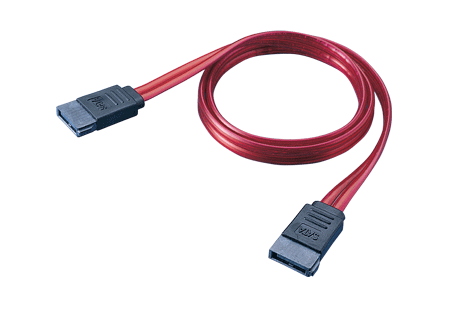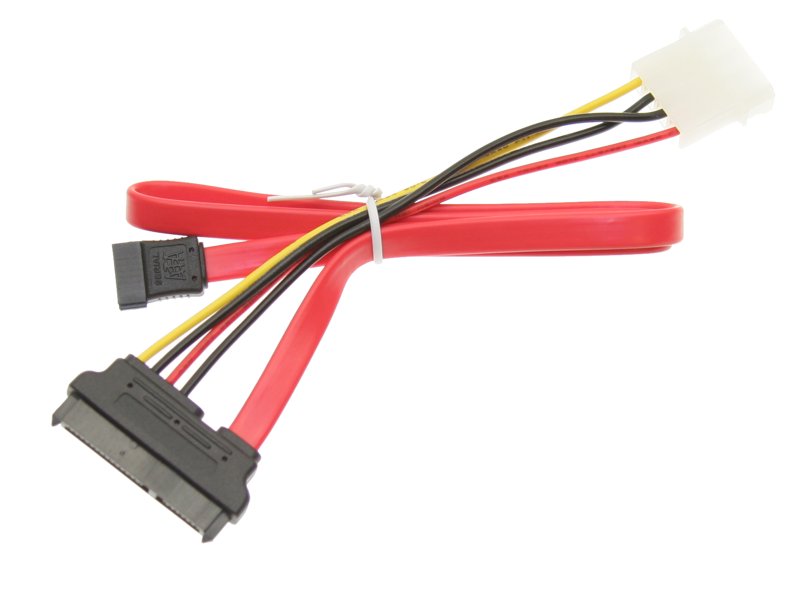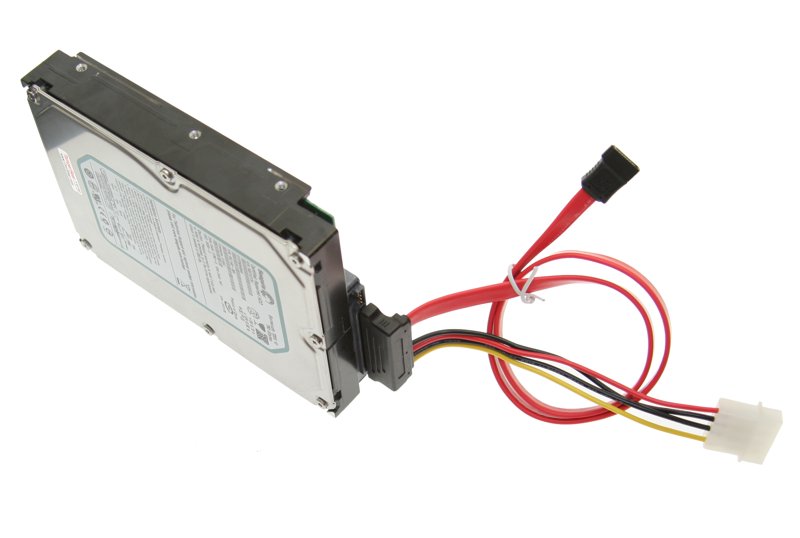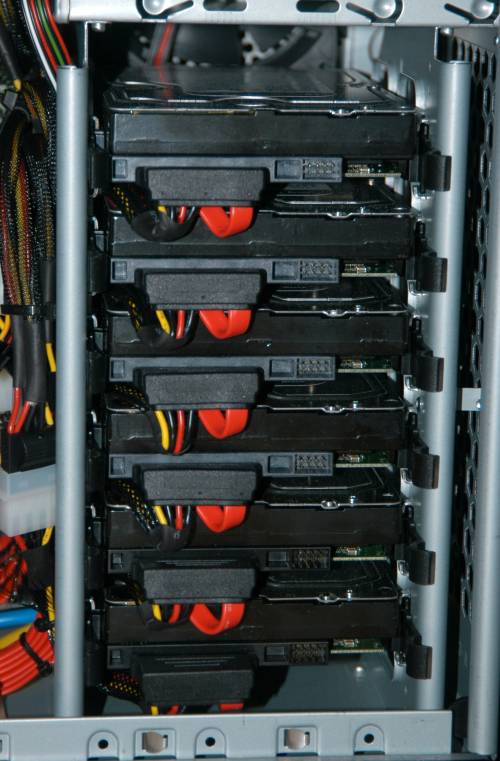Fantastic Hard Drive Cable
In my line of work I work with a lot of computer parts, and in fact every computer and computer server I use I have built myself. (With the exception of laptops.)
As a result I get a good deal of experience with just about every type of computer accessory and part, and also get a sense for the fragile parts or parts that tend to get designed poorly by manufacturers.
So I thought today I'd pass along a tip for anyone who is involved with replacing their hard drive, or simply wants to make their computer interior a little cleaner and safer.
My tip is for a hard drive cable — specifically for SATA hard drives (older hard drives use IDE connections, and they don't work with this cable, and in fact don't even need a cable of this type).
A SATA data cable normally looks something like this:
However, a hard drive also needs a power cable attached, and most off-the-shelf computers simply use a second 4-wire power cable, so each drive in the computer has a total of two cables attached to it.
Another way of doing things is to use a combination data/power cable, which typically looks like this:
With this cable, the large connection fits over both the data and power ports on the drive, and the other ends plug into their respective data and power ports within the computer.
I strongly recommend using a combination cable like this, because it helps mitigate a few basic problems with SATA connections:
- First, it cleans up some of the clutter caused by lots of cables inside the case. At first, many people think, "What's the point?" when it comes to un-cluttering the interior of a PC, but there is actually some real benefit. It can dramatically cut down on heat by allowing better circulation (hence making the computer last longer), and it makes working inside the case much safer and less error-prone. It is very easy to accidentally plug the wrong plug when wires get tangled in a mess.
- Even though they are light-years better that IDE connectors, SATA connectors do have a couple flaws in their design. One such flaw is that it is easy for the cable to come unplugged because there is no built-in latching mechanism. By combining the data with the power into one larger connector, it makes the connection sturdier and less apt to come unplugged.
- A connector like this will also leave the main power cables from the power supply farther away from the drives, which in my book is a good thing. I find power supply cables to be unwieldy in most instances, and I like to keep them coiled near the power supply, if possible.
However, there is still a problem with the combination data/power cable pictured above, and there is only one cable I've found that solves the issue.
The problem is a second basic flaw of SATA connectors: they break easily. Fortunately I've never had one break myself, but I've been close. I've heard many stories of hard drives being ruined by a simple broken connector.
If you look at the combination cable above, you'll notice that as the data and power cables exit from the drive (the large connector), they come straight out from the connector.
Having both data and power cables coming straight out actually creates a leverage point, with the drive connector itself being the weak point. If those cables get forced up or down too hard, it can be easy to break the drive connector.
Inside many computer cases, there are either fans located behind the hard drives (for cooling) or else the drives can be in a cramped space, or perhaps the cables are barely long enough and need to be bent pretty hard in order to stretch all the way to the SATA ports. In any of these situations, the straight-out cable configuration can be potentially dangerous for the hard drive connectors, and it will definiitely stress the connectors over time.
I have finally located a SATA cable that fixes all of the above problems, which is why I was compelled to write this tip. You can have all the benefits of a combination cable, without the risk that your drive connectors will snap off.
I have no idea why these cables are not sold everywhere, because they make so much sense. I find them so valuable that I always order more than I need, so that I'll have extras around when I need them.
And did I mention that they're cheap? I fully expected a niche item like this to cost $15 a piece, but surprisingly they are currently offered for just $2.51 per cable!
The subtle difference between this good cable and the one that risks your connectors is that it is set at an angle, with the cables exiting from the connector at a down-angle.
Here is the good cable, shown attached to a hard drive:
See how the cables come off the drive in a downward angle? That takes all the stress off the cable, helping to ensure the connectors stay in one piece.
To show what a big difference these cables make, let me show you a 6-drive array that I built using these cables.
(In case you're wondering, each of those drives is a 1TB drive, making a 4TB RAID-5 array.)
Because there is separation between the drives, I was able to use that space to route the cables, yet not restrict airflow. This has the following benefits:
- The cables are completed protected from getting pulled or pushed accidentally.
- If I need to remove a drive I can do it without removing the rest of the drives (which would not be possible if all the cables were routed down the backs of the drives).
- Completely organized and uncluttered.
- Fits nicely in what would otherwise have been a very difficult squeeze. (The computer case cover closes within an inch or two of the backs of the drives. If the cables came straight out they would probably be mashed against the case.)
So where can you get these cables? The only place I've found is at CoolDrives.com. Their Web site says that the price of $2.51 is a sale price, but it's been at that level for a long time, so I take it to be a regular price.
I don't recommend that someone who has never worked inside a computer case go rushing out to outfit their computer with new cables, but for someone who has done it a few times, this combination SATA data+power angled cable may be just the thing.




8 Comments:
Fascinating, thanks for the tutorial! Great info!! Assume those cables can be used on a conventional desktop.
By konane, at 2:19 PM
I work with mostly IDE and SCSI drives and I am familiar with the Serial ATA. For my own info: on the pics you have posted it looks like the power connector on the SATA has the grounds paired with the 5Volt and 12 volts that is red blk yellow blk, on IDE's and SCSI's the middle two are the grounds and the voltages are on the edges tp plug into the power supply red blk blk yellow, never looked closely at the SATA power connector.... I have one of those external IDE SATA interfaces to USB2.0 I'm gonna have to check the kit and see if the cable looks like the one pictured, because they send an external 5V 12V power pack for spinning up the external drive and I've only used it with 3.5" and 2.5" IDE's. Thanks for the info.
By jarasan, at 3:10 PM
That is a very good price, my WinXp Pc came with a sata drive and cables (It allows for several sata hardrives to be connected to the motherboard if I change it into a bigger case), but an IDE hardrive can also be connected to it if I want to as it also has a connector for it and I have done it just for testing that kind of setup and then undone it.
I myself use a multiboot setup, one copy of WinXP cloned into many partitions.
By LANTERN, at 4:18 PM
Sure enough, the SATA drive power connector has a different physical connector than the IDE! It is included in my kit to place between the AC/DC power adapter and the SATA drive power connection, wouldn't have been able to use the IDE power adapter connector alone.
The power connectors used for IDE drives are called MOLEX connectors they've been the standard for years, very difficult to insert incorrectly as they are keyed and are prong to socket receiver.
The new style SATA connectors if applied separately are may be more prone to incorrect attachment to drives physical power connection as they are small keyed flat edge connectors. Tighter engineering specs for sure.
The combo cable you show up there is fool-proof, Thanks.
By jarasan, at 11:00 PM
@Konane: Yes, assuming it uses SATA hard drive(s). The other technology is IDE, which isn't used in computers built in the past few years. IDE drives are starting to become harder to find these days. If your hard drive is connected with a wide, flat, ribbed cable (typically gray), about 2 inches wide, then that's an IDE drive, and you would not use a cable like the one I mentioned here.
@jarasan: Look at the third picture carefully and you will see that the SATA power configuration (pin-out order) is different than a standard 4-pin molex. Click on the image to see a large version. You can see the black and red wires cross-over.
I actually modified my cables slightly, and you can barely see it in the fourth picture. I popped off the molex plug, put a mesh wrap around the colored wires, shrink-wrapped black tubing around the ends of the mesh, and re-fastened the molex plug. When working on a PC with a great number of wires in the case, have found that enormously helpful. (In that particular case, in addition to the 6-drive SATA RAID-5 array, I also have a 3-drive SAS RAID-1E array, so it's wire-central in there.)
@Lantern: The beauty of hard drives these days is that they are incredibly *cheap*. You can find a 500GB drive for about $50. That's crazy-cheap. And with drives so cheap, I wouldn't even mess around with partitions. If you're going to install different operating systems, you might even want to do it on separate HDs. That way if one is trashed it won't affect the other.
Also, these days, the other technique is not to dual-boot, but to simply use virtual machines (like VM-Ware or Microsoft's free Virtual PC). That's how I'm able to test so many different OS/browser combinations. Without virtual machines, I'd have to have a bank of PCs setup just for testing. (I remember the days very clearly when that was the only way to do it.)
By Todd, at 11:08 PM
Thanks much Todd, my current drive is IDE, but like Lantern's computer you can use SATA, SATA cables came with it to use RAID but I didn't set it up for that. Asus P4P800 MB. Current HD is getting age on it so considering options. Great info, thank you!!
By konane, at 11:20 PM
@Konane: One of the best deals on the market for hard drives is currently the Western Digital Caviar Black 1 TB drive. It the fastest 1 TB hard drive on the market (or close to the fastest, depending on which benchmark you look at), and you can get it for about $120 or so.
WD also makes a slower "green" version of the drive, but I recommend going for speed (I've owned both drives).
By Todd, at 8:17 AM
Thanks very much Todd! Will look into that one because of having had WD recommended on the basis of durability and long term dependability. LOL will take speed any day.
By konane, at 9:28 AM
Post a Comment
<< Home